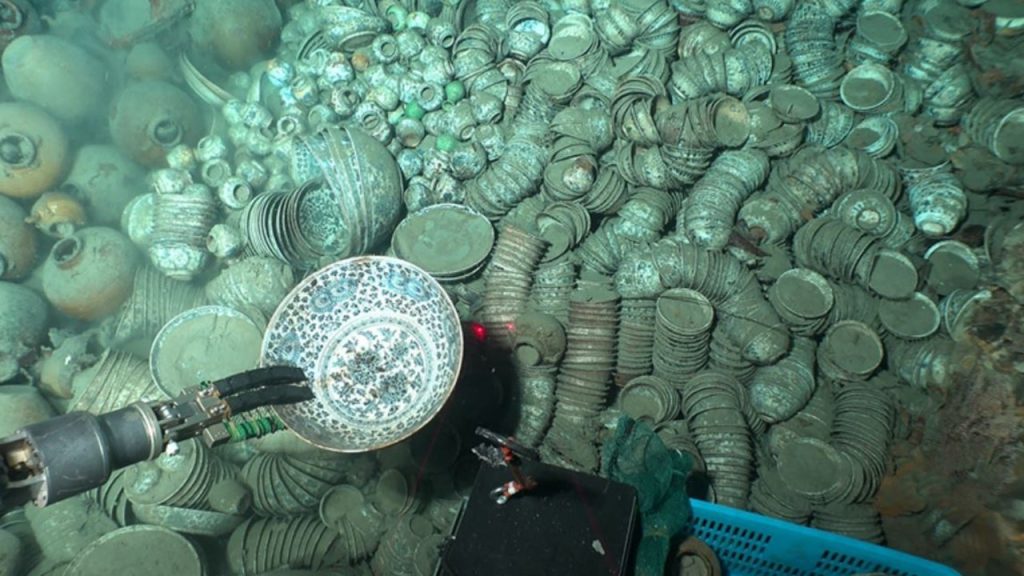Nearly 1,000 cultural relics dating back to the Ming Dynasty have been recovered from shipwrecks in the South China Sea. These relics include porcelain, pottery, copper coins, and deer antlers, indicating the importance of the South China Sea as a trade route during that time. The wrecks were first discovered in 2022 at a depth of 5,000 feet near the northwest continental slope of the South China Sea. The excavations of the shipwrecks began last year and have yielded a total of 890 relics from the first wreck and 38 from the second wreck, including pottery, porcelain, turban shells, and lumber.
Excavators used the manned Deep Sea Warrior submersible to retrieve the items from the shipwrecks. The first shipwreck appears to have mainly exported porcelain, while the second ship may have imported wood. The ships were found 10 nautical miles apart, and the well-preserved relics are of high historical, scientific, and artistic value. The relics are believed to be from the Zhengde period of the Ming Dynasty from 1506 to 1521, with some items possibly dating back to the reign of Emperor Hongzhi from 1488 to 1505. The discovery of these ancient ships is significant as it is the first time that ships sailing and returning to the same sea area have been discovered in China.
China’s National Cultural Heritage Administration stated that the excavation of these shipwrecks is likely to be a world-class archaeological discovery in the deep sea. This finding is relevant to China’s territorial claims on the South China Sea, particularly with its “nine-dash-line” policy, which has been disputed in international court. The discovery of nearly 1,000 cultural relics from the Ming Dynasty provides valuable insights into the maritime history of China and its connections with other regions through the Maritime Silk Road. The underwater excavation of these shipwrecks sheds light on the trade networks and cultural exchange during the Ming Dynasty.
The underwater excavation of the shipwrecks in the South China Sea offers a glimpse into the trade activities and seafaring routes used by people during the Ming Dynasty. The discovery of these relics, including porcelain, pottery, and copper coins, provides tangible evidence of the importance of the South China Sea as a trade route during that time. The detail and preservation of the relics found in the shipwrecks highlight the historical, scientific, and artistic significance of this discovery. The identification of the relics from the Zhengde period of the Ming Dynasty further enriches our understanding of maritime trade and cultural connections during that era.
The preliminary judgment of the cultural relics found in the wrecks points to their origins in the Zhengde period of the Ming Dynasty, with some items possibly dating back to the reign of Emperor Hongzhi. The neatly stacked logs found on one of the ships suggest that they were intended for trade or construction purposes. The discovery of these ancient ships sailing the same sea area for sailing and returning is a unique find in China and provides a rare opportunity to study the maritime history of the region. The excavation of these shipwrecks, using advanced technology such as the Deep Sea Warrior submersible, represents a significant step in underwater archaeology and cultural heritage preservation in China.
Overall, the recovery of nearly 1,000 cultural relics from the Ming Dynasty shipwrecks in the South China Sea marks an important archaeological discovery with global significance. This finding offers valuable insights into the trade networks, cultural exchange, and maritime activities of the Ming Dynasty. The well-preserved relics, including porcelain, pottery, and copper coins, provide a tangible link to the past and highlight the historical and artistic value of the underwater excavation. The identification of these relics from specific periods of the Ming Dynasty further enhances our understanding of China’s maritime history and its connections with other regions.


